Spatial Distribution Pattern and Influencing Factors of Homestays in Chongqing, China
Abstract
:1. Introduction
2. Materials and Methods
2.1. Data
2.2. Methods
2.2.1. Average Nearest Neighbor
2.2.2. Kernel Density Estimation
2.2.3. Preparation of Variables and Model Building
3. Results
3.1. Spatial Distribution Characteristics of Homestays
3.2. Spatial Heterogeneity of Factors Affecting the Spatial Distribution of Homestays
3.3. Spatial Differentiation of Influencing Factors
4. Discussion
4.1. Complexity and Spatial Heterogeneity of Influencing Factors of Homestays Distributions
4.2. Possible Problems of Homestay Development and the Path of Urban–Rural Integration
4.3. Research Limitations
5. Conclusions
Author Contributions
Funding
Institutional Review Board Statement
Informed Consent Statement
Data Availability Statement
Acknowledgments
Conflicts of Interest
References
- Qu, J.Y. A study on the development of Xitang’s homestay tourism from the perspective of consumer purchase behaviour. J. Discret. Math. Sci. Cryptogr. 2018, 21, 1401–1406. [Google Scholar] [CrossRef]
- Cheng, H.; Yang, Z.; Liu, S.J. Rural stay: A new type of rural tourism in China. J. Travel Tour. Mark. 2020, 37, 711–726. [Google Scholar] [CrossRef]
- Fan, X.Q.; Lu, Z.L.; Wu, H.X. Current Situation of Rural Residents’ Tourism: A Case Study in Zhejiang Province in China. Asia Pac. J. Tour. Res. 2014, 19, 1191–1206. [Google Scholar] [CrossRef]
- Wang, L.E.; Cheng, S.K.; Zhong, L.S.; Mu, S.L.; Dhruba, B.G.C.; Ren, G.Z. Rural tourism development in China: Principles, models and the future. J. Mt. Sci. 2013, 10, 116–129. [Google Scholar] [CrossRef]
- Lin, Y.C.; Lai, H.J.; Morrison, A.M. Social servicescape and Asian students: An analysis of spring break island bed and breakfast experiences in Taiwan. Tour. Manag. Perspect. 2019, 31, 165–173. [Google Scholar] [CrossRef]
- Yuan, J.X.; Tsai, T.; Chang, P.W. Toward an entrepreneurship typology of Bed and Breakfasts. J. Hosp. Tour. Res. 2018, 42, 1315–1336. [Google Scholar] [CrossRef]
- Liu, C.Y.; Dou, X.T.; Li, J.F.; Cai, L.P. Analyzing government role in rural tourism development: An empirical investigation from China. J. Rural Stud. 2020, 79, 177–188. [Google Scholar] [CrossRef]
- Gao, J.; Wu, B.H. Revitalizing traditional villages through rural tourism: A case study of Yuanjia Village, Shaanxi Province, China. Tour. Manag. 2017, 63, 223–233. [Google Scholar] [CrossRef]
- Liu, H.Y.; Weng, D.L.; Liu, H.G. Decoding Rural Space Reconstruction Using an Actor-Network Methodological Approach: A Case Study from the Yangtze River Delta, China. Land 2021, 10, 1110. [Google Scholar] [CrossRef]
- Nuntsu, N.; Tassiopoulos, D.; Haydam, N. The bed and breakfast market of Buffalo City(BC), South Africa: Present status, constraints and success factors. Tour. Manag. 2004, 25, 515–522. [Google Scholar] [CrossRef]
- Li, Y.; Miao, L.; Zhao, X.Y.; Zhao, X.Y.; Lehto, X. When family rooms become guest lounges: Work-family balance of B&B innkeepers. Int. J. Hosp. Manag. 2013, 34, 138–149. [Google Scholar] [CrossRef]
- Sharif, N.M.; Lonik, K.A.T. Engagement of local community in tourism Entrepreneurship: A Case Study of Perhentian Island, Malaysia. J. Nusant. Stud.-Jonus 2018, 3, 103–119. [Google Scholar] [CrossRef]
- Serrano-Barquin, R.; Colin, R.; Palmas-Castrejon, D.; Zarza-Delgado, P.P.; PpzdOsorio-Garcia, M. Women’s Participation in Lodging Sector. The Case of Family-Owned Bed and Breakfast in Tonatico, Mexico. Rosa Dos. Ventos-Tur. E Hosp. 2017, 9, 318–337. [Google Scholar] [CrossRef]
- BirendraI, K.C. Ecotourism for wildlife conservation and sustainable livelihood via community-based homestay: A formula to success or a quagmire? Curr. Issues Tour. 2021, 24, 1227–1243. [Google Scholar] [CrossRef]
- Pasanchay, K.; Schott, C. Community-based tourism homestays? capacity to advance the Sustainable Development Goals: A holistic sustainable livelihood perspective. Tour. Manag. Perspect. 2021, 37, 100784. [Google Scholar] [CrossRef]
- Kontogeorgopoulos, N.; Churyen, A.; Duangsaeng, V. Homestay Tourism and the Commercialization of the Rural Home in Thailand. Asia Pac. J. Tour. Res. 2015, 20, 29–50. [Google Scholar] [CrossRef]
- Ferreira, J.P.; Ramos, P.N.; Lahr, M.L. The rise of the sharing economy: Guesthouse boom and the crowding-out effects of tourism in Lisbon. Tour. Econ. 2020, 26, 389–403. [Google Scholar] [CrossRef]
- Chio, J. Leave the Fields without Leaving the Countryside: Modernity and Mobility in Rural, Ethnic China. Identities-Glob. Stud. Cult. Power 2011, 18, 551–575. [Google Scholar] [CrossRef]
- Park, C.H. Nongjiale Tourism and Contested Space in Rural China. Mod. China 2014, 40, 519–548. [Google Scholar] [CrossRef]
- Sang, S.Y.; Ha, S.N. How Social Media Influences Resident Participation in Rural Tourism Development: A Case Study of Tunda in Tibet. Journal of Tourism and Cultural Change. Available online: https://www.tandfonline.com/doi/full/10.1080/14766825.2020.1849244?scroll=top&needAccess=true (accessed on 18 November 2020).
- Zhao, Y.W. When guesthouse meets home: The time-space of rural gentrification in southwest China. Geoforum 2019, 100, 60–67. [Google Scholar] [CrossRef]
- Jiang, J.Q.; Li, Y. A review of the international and domestic researches on Minshuku. Tour. Res. 2014, 6, 16–22. (In Chinese) [Google Scholar] [CrossRef]
- Zhang, G.H.; Meng, Y. Progress of domestic and international research on B&B tourism. Resour. Dev. Mark. 2017, 33. (In Chinese) [Google Scholar] [CrossRef]
- Zhang, X.; Tang, J. A Study of Emotional Solidarity in the Homestay Industry between Hosts and Tourists in the Post-Pandemic Era. Sustainability 2021, 13, 7458. [Google Scholar] [CrossRef]
- Wang, M.Y.; Wu, Z.J.; Hou, Y.X. A Literature Review of Homestay Accommodation Based on Bibliometrics. Tour. Res. 2019, 11, 58–73. (In Chinese) [Google Scholar] [CrossRef]
- Janjua, Z.U.; Krishnapillai, G.; Rahman, M. A Systematic Literature Review of Rural Homestays and Sustainability in Tourism. Sage Open 2021, 11, 21582440211007117. [Google Scholar] [CrossRef]
- Hu, X.F.; Li, X.Y.; Wang, T.Y.; Zhao, H.M.; Yang, S.; Deng, L.; LI, J.W. Spatial agglomeration pattern of homestay inn and influencing factors based on the comparison of Hangzhou, Huzhou, and Enshi cities. Prog. Geogr. 2020, 39, 1698–1707. [Google Scholar] [CrossRef]
- Ma, X.B.; Hou, G.L.; Li, L.; Yang, Y. Cluster identification, distribution patern and influencing factors of B&B based on DBSCAN: A Case Study of Nanjing. Hum. Geogr. 2021, 36, 84–93. (In Chinese) [Google Scholar] [CrossRef]
- Long, F.; Liu, J.; Zhu, H.; Li, T. Spatial distribution of homestay and its influencing factors in the Yangtze River Delta of China. Geogr. Res. 2019, 38, 950–960. [Google Scholar] [CrossRef]
- Zhang, H.Z.; LU, L.; Zhang, D.P.; Yu, H.; Zhang, X. Spatial pattern and contributing factors of homestay inns in the area around Mogan Mountain. Geogr. Res. 2019, 38, 2695–2715. (In Chinese) [Google Scholar] [CrossRef]
- Mei, L.; Jiang, H.Q. The spatial differentiation process, factors and trends of B&B in Beijing based on Airbnb data. Econ. Geogr. 2021, 41, 213–222. (In Chinese) [Google Scholar] [CrossRef]
- Long, F.; Liu, J.M.; Zhang, S.Y.; Yu, H.; Jiang, H. Development Characteristics and Evolution Mechanism of Homestay Agglomeration in Mogan Mountain, China. Sustainability 2018, 10, 2964. [Google Scholar] [CrossRef]
- Chen, Y.C.; Yang, R.; Wang, M. Development process of rural homestay tourism and spatial restructuring with the actor-network method from the perspective of shared economy: A case study of Guanhu Village in Shenzhen. Prog. Geogr. 2018, 37, 718–730. (In Chinese) [Google Scholar] [CrossRef]
- Li, Y.Q.; Yu, W.B.; Bai, Y.F. Comparative research on B&B of Beijing and Taipei based on ratings on the Airbnb website. Chin. J. Manag. 2017, 14, 122–128, 138. (In Chinese) [Google Scholar] [CrossRef]
- Wu, X.J.; Qiu, J.L. A study of Airbnb listing price determinants: Based on data from 36 cities in China. Tour. Trib. 2019, 34, 13–28. (In Chinese) [Google Scholar] [CrossRef]
- Sun, J.W.; Ma, Y.J.; Wang, Z.B.; Zhang, M. New rural social relations framework and promotion path from the perspective of agricultural-travel integration: A case study of Chenjie village in Jinhua, Zhejiang province. Geogr. Res. 2020, 39, 696–708. (In Chinese) [Google Scholar] [CrossRef]
- Liu, Y.; Fan, P.L.; Yue, W.Z.; Song, Y. Impacts of land finance on urban sprawl in China: The case of Chongqing. Land Use Policy 2018, 72, 420–432. [Google Scholar] [CrossRef]
- Ghodousi, M.; Sadeghi-Niaraki, A.; Rabiee, F.; Choi, S.M. Spatial-Temporal Analysis of Point Distribution Pattern of Schools Using Spatial Autocorrelation Indices in Bojnourd City. Sustainability 2020, 12, 7755. [Google Scholar] [CrossRef]
- De-Oliveira, W.K.; De-Franca, G.V.A.; Carma, E.H.; Duncan, B.B.; Kuchenbecker, R.D.; Schmidt, M.I. Infection-related microcephaly after the 2015 and 2016 Zika virus outbreaks in Brazil: A surveillance-based analysis. Lancet 2017, 390, 861–870. [Google Scholar] [CrossRef]
- Kuang, B.; Lu, X.H.; Zhou, M.; Chen, D.L. Provincial cultivated land use efficiency in China: Empirical analysis based on the SBM-DEA model with carbon emissions considered. Technol. Forecast. Soc. Chang. 2020, 151, 119874. [Google Scholar] [CrossRef]
- Ma, H.Q.; Xi, J.C.; Wang, Q.; Liu, J.L.; Gong, Z.G. Spatial Complex Morphological Evolution and Influencing Factors for Mountain and Seaside Resort Tourism Destinations. Complexity 2020, 2020, 4137145. [Google Scholar] [CrossRef]
- Li, L.; Lu, L.; Xu, Y.C.; Sun, X.L. The spatiotemporal evolution and influencing factors of hotel industry in the metropolitan area: An empirical study based on China. PLoS ONE 2020, 15, e0231438. [Google Scholar] [CrossRef]
- Lai, P.H.; Lyons, K. Place-meaning and Sustainable Land Management: Motivations of Texas Hill Country Landowners. Tour. Geogr. 2011, 13, 360–380. [Google Scholar] [CrossRef]
- Hu, X.F.; Li, X.Y.; Zhao, H.M.; Deng, L. Spatial variation characteristics and influencing factors of homestay inn price: A case study of Enshi, Hubei. J. Nat. Resour. 2020, 35, 2473–2483. [Google Scholar] [CrossRef]
- Zheng, B.M.; Ming, Q.Z.; Liu, A.L.; Zhang, X. Research on the center of gravity coupling and interactive response between tourism economic efficiency and regional economic level in Western Provinces. World Reg. Stud. 2022, 31, 350–362. (In Chinese) [Google Scholar] [CrossRef]
- Fei, J.H.; Lin, Y.; Jiang, Q.T.; Jiang, K.H.; Li, P.L.; Ye, G.Q. Spatiotemporal coupling coordination measurement on islands’ economy-environment-tourism system. Ocean Coast. Manag. 2021, 212, 105793. [Google Scholar] [CrossRef]
- De, L.G.; Rosciano, M. Quantile Dependence in Tourism Demand Time Series: Evidence in the Southern Italy Market. Sustainability 2020, 12, 3243. [Google Scholar] [CrossRef]
- Wu, Q.Y.; Cheng, J.Q. A temporally cyclic growth model of urban spatial morphology in China: Evidence from Kunming Metropolis. Urban Stud. 2019, 56, 1533–1553. [Google Scholar] [CrossRef]
- Kanwal, S.; Rasheed, M.I.; Pitafi, A.H.; Pitafi, A.; Ren, M.L. Road and transport infrastructure development and community support for tourism: The role of perceived benefits, and community satisfaction. Tour. Manag. 2020, 77, 104014. [Google Scholar] [CrossRef]
- Al-Mulali, U.; Fereidouni, H.G.; Lee, J.Y.; Sab, C. Exploring the relationship between urbanization, energy consumption, and CO2 emission in MENA countries. Renew. Sustain. Energy Rev. 2013, 23, 107–112. [Google Scholar] [CrossRef]
- Dadashpoor, H.; Azizi, P.; Moghadasi, M. Land use change, urbanization, and change in landscape pattern in a metropolitan area. Sci. Total Environ. 2019, 655, 707–719. [Google Scholar] [CrossRef]
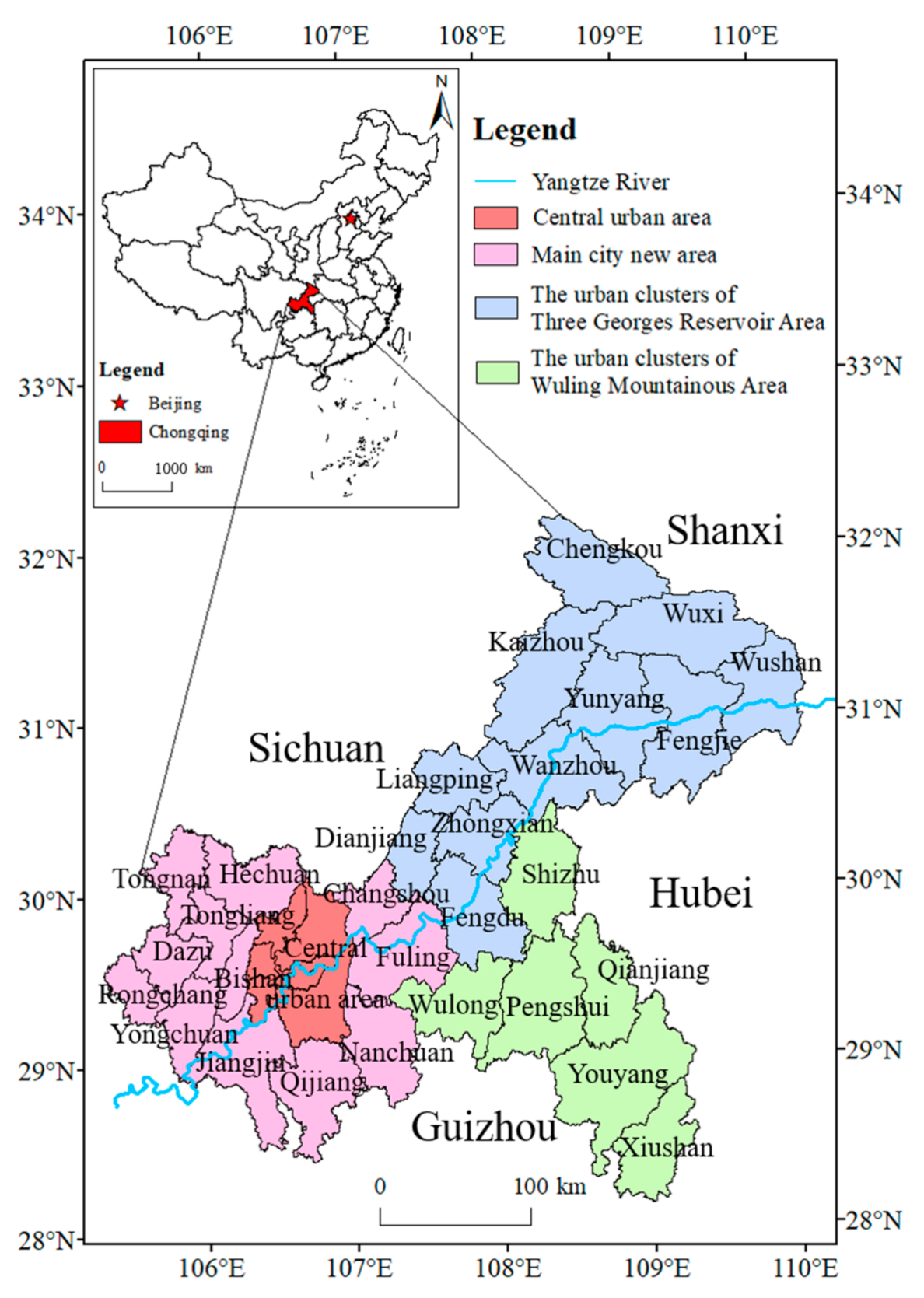

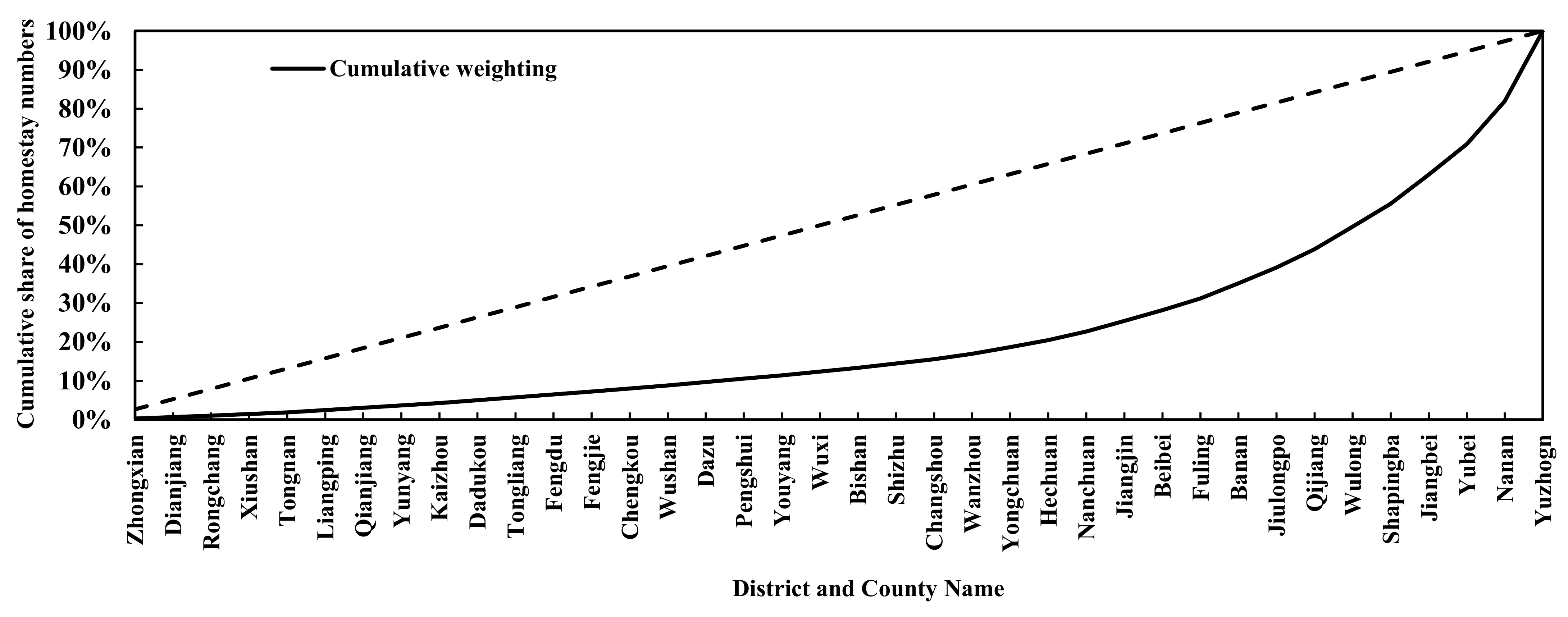
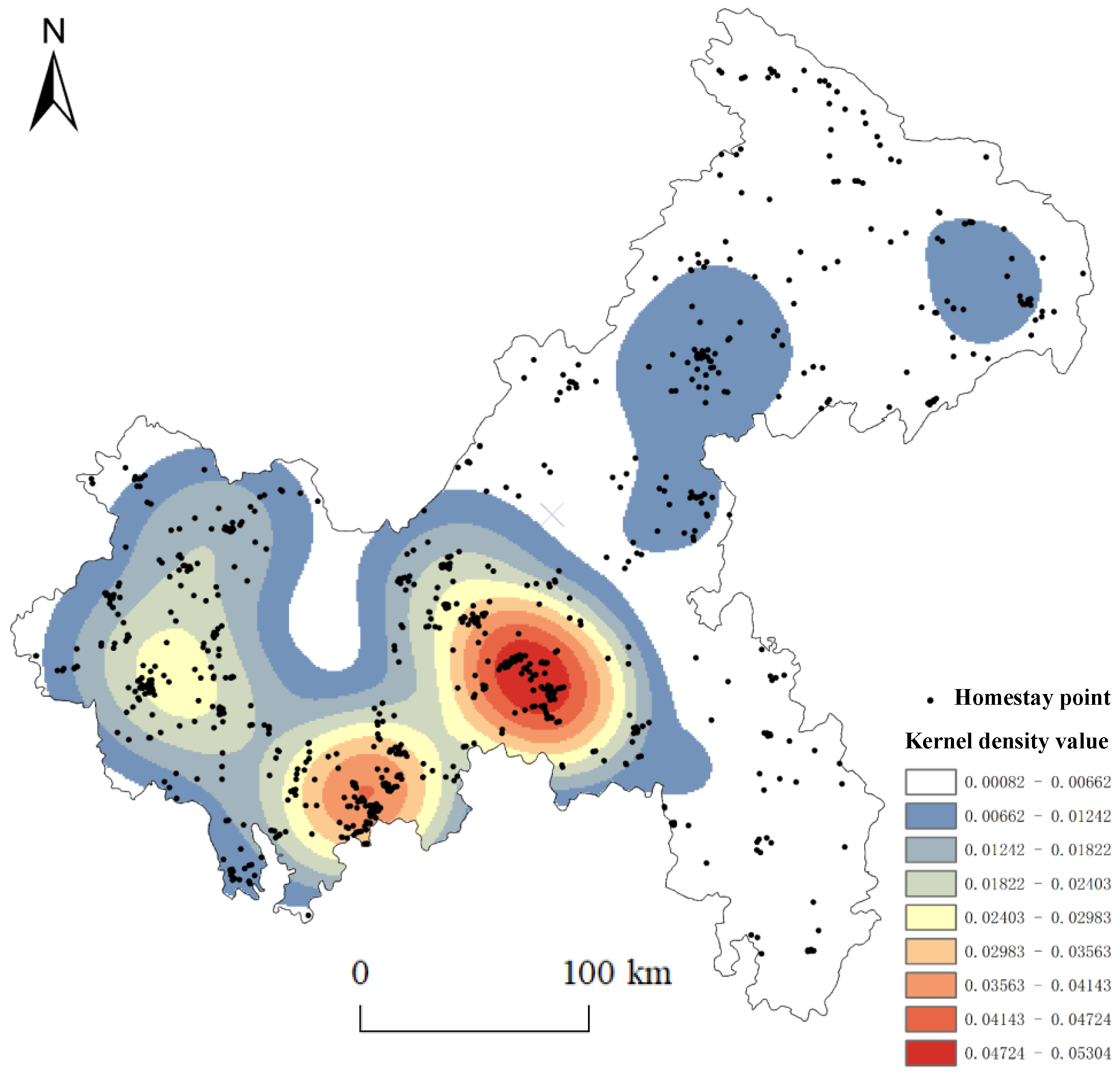
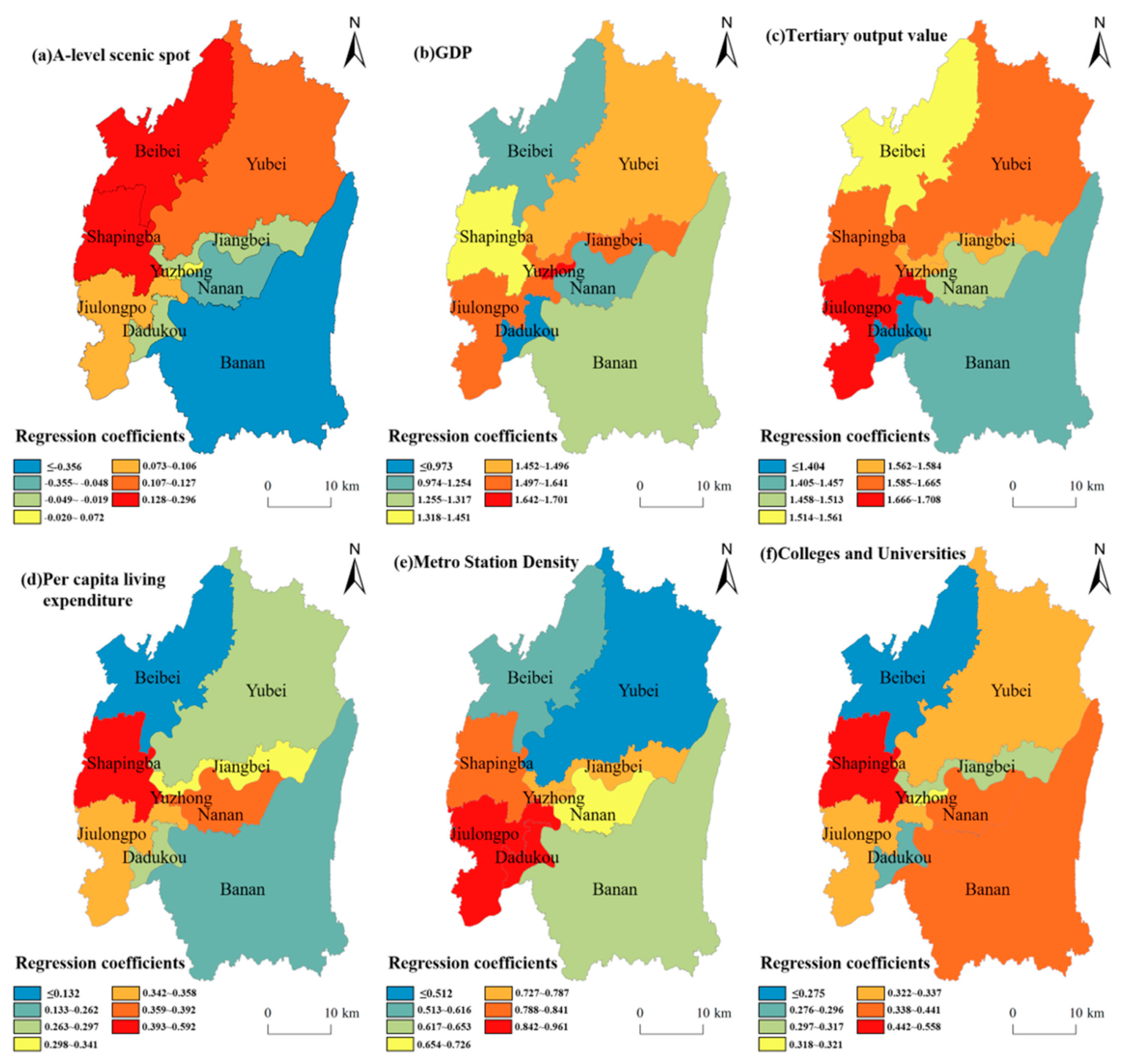
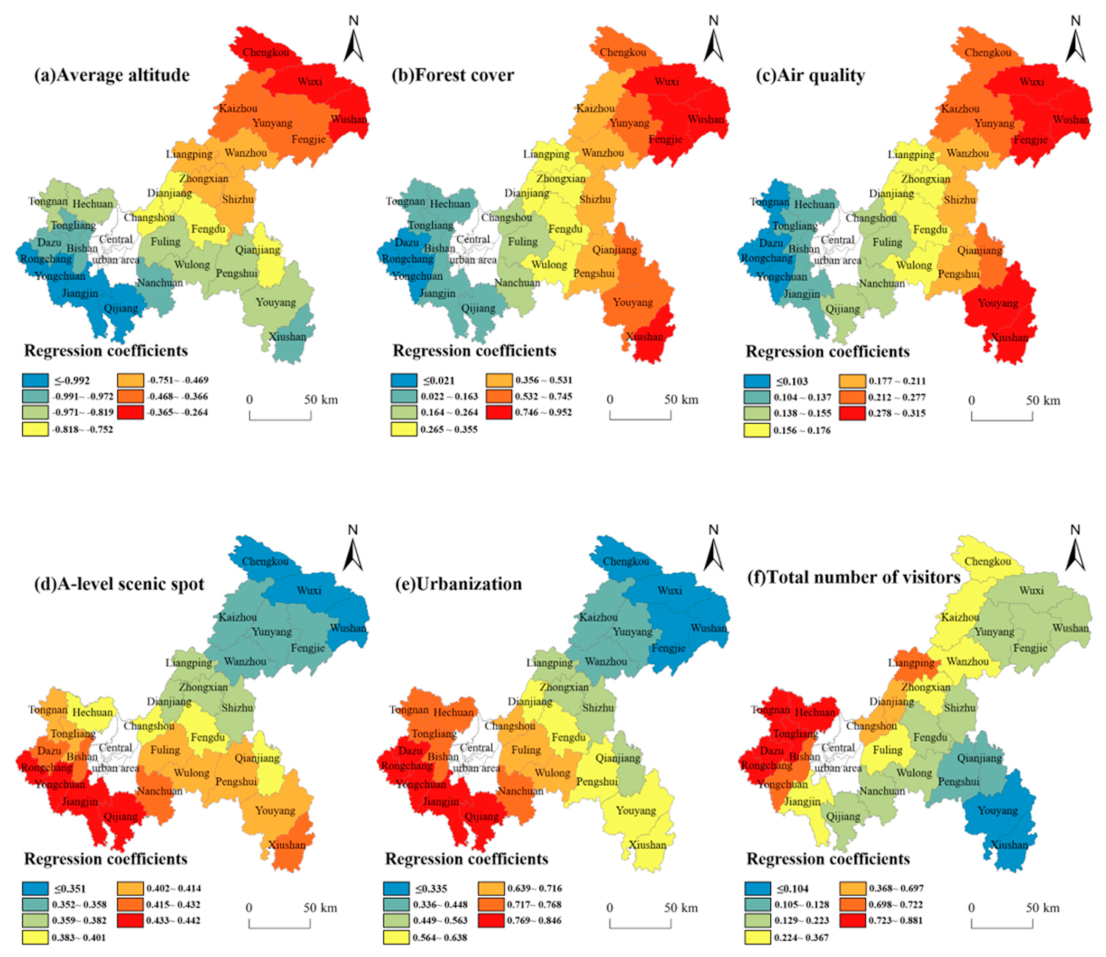
| Types | Names | Paraphrase |
|---|---|---|
| Independent variable | Number of homestays | Number of homestays in districts and counties |
| Natural geographical conditions | Average altitude | Average altitude of the region |
| Forest-cover rate | Regional forest cover | |
| Air-quality rate | Percentage of days with good air quality in the region | |
| A-level scenic spot | Number of A-level scenic spots in the region | |
| Regional economic conditions | GDP | Regional annual gross domestic product |
| Total tourism revenue | Total annual revenue of regional tourism | |
| Output value of primary industry | Regional agricultural annual gross product | |
| Output value of tertiary industry | Annual total revenue of regional service industry | |
| Per capita disposable income of residents | Per capita disposable income of local residents | |
| Residents’ per capita living consumption expenditure | Per capita living consumption expenditure of regional residents | |
| Accommodation and catering industry turnover | Regional accommodation and catering industry turnover | |
| Social development conditions | Permanent residents | Regional resident population |
| Urbanization rate | Urban population/total population | |
| Road network density | Total regional highway mileage/area | |
| Total number of visitors | The total number of tourists received by the regional tourism industry | |
| Metro station density | Number of metro stations/area | |
| College density | Number of regional colleges and universities |
| Names | Observed Mean Distance (m) | Expected Mean Distance (m) | Nearest Neighbor Ratio | Distribution Types |
|---|---|---|---|---|
| Chongqing | 922.9240 | 3747.5492 | 0.246274 | Agglomeration |
| Central urban area | 318.5892 | 970.6503 | 0.328222 | Agglomeration |
| Main city new District | 1541.8764 | 3940.5550 | 0.391284 | Agglomeration |
| The urban agglomeration of Wuling Mountain Area | 1706.9458 | 5171.3703 | 0.330076 | Agglomeration |
| The urban agglomeration of Three Gorges Reservoir Area | 3384.9553 | 7545.0662 | 0.448631 | Agglomeration |
| Model Parameters | Coefficient | t-Value | p-Value | VIF |
|---|---|---|---|---|
| Central Urban Area | ||||
| A-level scenic spot | 0.662 | 2.474 | 0.023 * | 2.959 |
| GDP | 0.512 | 1.677 | 0.031 * | 3.001 |
| Tertiary output value | 0.149 | 3.376 | 0.015* | 2.223 |
| Per capita living expenditure | 0.648 | 4.069 | 0.017 * | 1.987 |
| Metro station density | 0.818 | 4.106 | 0.009 ** | 1.108 |
| Colleges and universities | 0.203 | 5.936 | 0.004 ** | 1.107 |
| The areas outside the central urban area | ||||
| Average altitude | 0.325 | 3.602 | 0.016 * | 2.892 |
| Forest cover | 0.276 | 1.513 | 0.025 * | 3.584 |
| Air quality | 0.401 | 1.251 | 0.046 * | 5.468 |
| A-level scenic spot | 0.461 | 2.017 | 0.032 * | 5.179 |
| Urbanization | 0.336 | 5.193 | 0.008 ** | 4.866 |
| Total number of visitors | 0.201 | 5.891 | 0.005 ** | 2.401 |
| R2 | Adjust-R2 | AICc | |
|---|---|---|---|
| OLS in central urban area | 0.57 | 0.45 | 116.88 |
| GWR in central urban area | 0.87 | 0.66 | 78.21 |
| OLS the outside the central urban area | 0.68 | 0.31 | 53.12 |
| GWR the outside the central urban area | 0.72 | 0.65 | 20.85 |
| Independent Variable | Minimum | Upper Quantile | Median | Lower Quantile | Maximum | Average |
|---|---|---|---|---|---|---|
| Central Urban Area | ||||||
| A-level scenic spot | −0.356 | −0.188 | 0.073 | 0.111 | 0.296 | 0.126 |
| GDP | 0.973 | 1.114 | 1.453 | 1.569 | 1.701 | 1.356 |
| Tertiary output value | 1.405 | 1.432 | 1.563 | 1.626 | 1.708 | 1.557 |
| Per capita living expenditure | 0.132 | 0.196 | 0.341 | 0.369 | 0.592 | 0.336 |
| Metro station density | 0.512 | 0.565 | 0.726 | 0.814 | 0.961 | 0.728 |
| Colleges and universities | 0.275 | 0.286 | 0.318 | 0.326 | 0.356 | 0.313 |
| The Areas Outside the Central Urban Area | ||||||
| Average altitude | −0.991 | −0.971 | −0.752 | −0.266 | −0.264 | −0.662 |
| Forest cover | 0.021 | 0.066 | 0.355 | 0.745 | 0.952 | 0.428 |
| Air quality | 0.103 | 0.137 | 0.176 | 0.277 | 0.316 | 0.202 |
| A-level scenic spot | 0.351 | 0.359 | 0.401 | 0.424 | 0.432 | 0.395 |
| Urbanization | 0.335 | 0.449 | 0.639 | 0.769 | 0.846 | 0.617 |
| Total number of visitors | 0.104 | 0.128 | 0.223 | 0.797 | 0.881 | 0.371 |
Publisher’s Note: MDPI stays neutral with regard to jurisdictional claims in published maps and institutional affiliations. |
© 2022 by the authors. Licensee MDPI, Basel, Switzerland. This article is an open access article distributed under the terms and conditions of the Creative Commons Attribution (CC BY) license (https://creativecommons.org/licenses/by/4.0/).
Share and Cite
Wang, W.; Yang, Q.; Gan, X.; Zhao, X.; Zhang, J.; Yang, H. Spatial Distribution Pattern and Influencing Factors of Homestays in Chongqing, China. Appl. Sci. 2022, 12, 8832. https://doi.org/10.3390/app12178832
Wang W, Yang Q, Gan X, Zhao X, Zhang J, Yang H. Spatial Distribution Pattern and Influencing Factors of Homestays in Chongqing, China. Applied Sciences. 2022; 12(17):8832. https://doi.org/10.3390/app12178832
Chicago/Turabian StyleWang, Wenxin, Qingyuan Yang, Xia Gan, Xing Zhao, Junfan Zhang, and Han Yang. 2022. "Spatial Distribution Pattern and Influencing Factors of Homestays in Chongqing, China" Applied Sciences 12, no. 17: 8832. https://doi.org/10.3390/app12178832
APA StyleWang, W., Yang, Q., Gan, X., Zhao, X., Zhang, J., & Yang, H. (2022). Spatial Distribution Pattern and Influencing Factors of Homestays in Chongqing, China. Applied Sciences, 12(17), 8832. https://doi.org/10.3390/app12178832






